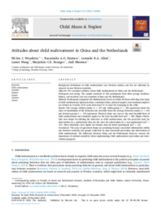Abstract
Background
Definitions of child maltreatment vary between studies, and few are informed by research in non-Western countries.
Objective
We examined attitudes about child maltreatment in China and the Netherlands.
Participants and setting
The sample consisted of 304 participants from three groups (mothers, fathers, and teachers) and two countries (China and the Netherlands).
Methods
Participants completed the Maltreatment Q-sort in which 90 items reflecting four types of child maltreatment (physical abuse, emotional abuse, physical neglect, and emotional neglect) are divided in 9 stacks of 10 cards from least (1) to most (9) damaging to the child.
Results
The average within-country (r = .57) and within-group (r = .58) agreement about the order of harmfulness of the behaviors did not differ from the average between-country (r = .49) and between-group (r = .53) agreement. Physical abuse was seen as the most harmful form of child maltreatment and emotional neglect as the least harmful form (pƞ2 = .88). Higher thresholds were found for labeling the behaviors as child maltreatment, and the perceived need for intervention by a professional than for the need for intervention by a non-professional (pƞ2 = .67). These thresholds were higher for Chinese than for Dutch participants (pƞ2 = .31).
Conclusions
The areas of agreement found are promising because successful collaboration within and between countries and groups could lead to more successful prevention and intervention of child maltreatment. The difference between China and the Netherlands however, stresses the importance of cultural sensitivity when implementing child maltreatment prevention and intervention programs.

